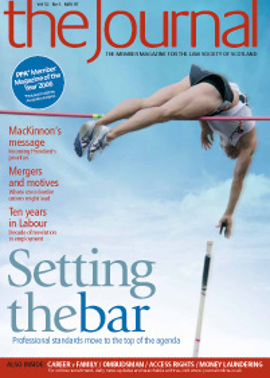Risk reinvented

IP/IT is one of the fastest evolving areas of the law. The speed of development of IP/IT law, fuelled by such factors as globalisation, consolidation of media companies, internet piracy and responses to phenomena like YouTube and MySpace, means that it remains very much a specialist area. In most respects, however, the relevant risk and risk management issues are those that arise in almost all areas of practice.
Managing the client
In my days in private practice, I noticed that IP clients (as in many other areas of practice) often fell into identifiable categories in terms of the particular risks associated with each. For example, self employed authors of copyright material were in my experience rarely familiar with contracts. While this was not in any way a fault on their part or any criticism of them, it did mean that they could have unrealistic ideas of budgets and how long work (e.g. drafting a publishing agreement) would take. Designers of websites, on the other hand, tended to be very technically focused and did not always give sufficient consideration to the legal compliance of the sites they created, or make allowance in project budgets for “legalling” of the finished product.
For first time applicants for patents, for example small inventors, or people starting new businesses with a large IP component, their appointment with their IP lawyer might well be their first exposure to legal work of any kind. This could be a potentially confusing experience for such a client, given the complexity of this area of the law (one new business startup might require advice on issues as diverse as patenting, passing off, registered trade marks, copyright, databases and designs, on both UK and European levels, as well as data protection and e-commerce law), and one moreover of which they probably have no contextual knowledge – unlike the experience and general knowledge they might have of the legal process involved in, say, buying a flat or house for the first time. Add to this complexity and strangeness the fact that, by its nature, IP is intangible (and the concepts therefore more difficult for clients to “get a handle on”), and the IP lawyer faces challenges which are more pronounced than in certain other areas of practice, in communicating with clients.
Risk management point: As with all clients, expectations as regards timescales, fees and the work involved need to be managed from the outset and any misunderstandings identified before they escalate into dissatisfaction and potential complaints. These are issues which should be addressed from the client/transaction vetting stage onwards, and covered when scoping the instruction with the client as part of the terms of engagement adjustment process prior to starting the work.
Clients’ responsibilities
As with all practitioners, IP solicitors can use terms of engagement to clarify clients’ obligations in the engagement, as well as their own. For example, when reviewing software licences the IP lawyer must be careful to flag up to their licensee clients the importance of the clients describing in as much detail as possible the performance standards required of the system in the specification included in the licence agreement. It is a standard feature of such agreements for the licensor (the software developer) to seek to exclude from the licensor’s indemnity any standard of merchantability, satisfactoriness or system performance (e.g. average downtime, response times etc) not stated in the specification.
The fitness of a software package for a particular client’s purposes is not something which any solicitor can warrant, so practitioners need to make clear to the licensee that it is the licensee’s responsibility to ensure that everything they want the system to be capable of is contained within the specification and that this is something the licensee will have to satisfy themselves on.
Risk management point: Such advice setting out the client’s responsibilities regarding the drafting of the specification might be included on a checklist of relevant points as a prompt to the solicitor when acting for licensees of software. The advice to the client should be recorded in writing on the file either in the form of a letter or a full attendance note.
Critical dates
Although critical dates may not feature as heavily in IP/IT work as they do in, for instance, litigation, they do arise in relation to assignations of trade marks (and patents). Clients, and their solicitors, sometimes forget that once an assignation of such IP has been signed (by statute it has to be in writing) by the grantor, it must then be sent to the Trade Marks Registry (part of the UK Intellectual Property Office – UKIPO) for recording. If this is not done within six months of the date of transfer, certain important remedies for infringement of the IP are not available to the assignee in respect of pre-recording infringements. Also, if an assignation is not registered then it will be void against an assignee in good faith under a later assignation. For both of these reasons it is in the assignee’s interest to arrange registration of the assignation document as soon as possible after the date of signing, and in any event no more than six months thereafter.
Risk management point: As always, critical dates need to be identified correctly, verified and diarised effectively with countdown warnings as appropriate.
Drafting
As with other areas of practice, use of templates in drafting IP/IT documentation is commonplace, requiring the usual controls over the hazards which this can entail (e.g. out of date, inaccurate, unapproved or incomplete styles).
On a risk assessed basis, certain provisions in particular may well justify being checked by a second pair of eyes, to help ensure that the proposed wording gives accurate effect to the client’s instructions. In the context of IP/IT for example, when drafting licences of patents of scientific techniques and inventions (often created by university academics), particular care needs to be taken over the definition of the income stream on which royalties will be calculated, and the specification of the field of use of the licensed technology being authorised by the licensor.
Instructions may sometimes be difficult to translate from academic, scientific language, and the IP lawyer must also be aware that academic clients may be as unfamiliar with the terminology of IP law as the solicitor is with the client’s technical terms.
Avoid the known traps
All areas of practice have their own particular snares, and IP/IT is no exception. Two of the potential pitfalls for the IP practitioner are the provisions in the Patents Act 1977 and the Trade Marks Act 1994 which create the delict of issuing groundless threats of enforcement action for the infringement of patents and registered marks. This means that, amongst other necessary considerations, practitioners instructed in contentious patent or trade mark matters, acting for the alleged owner of the IP, need to check that the relevant patent or trade mark is in fact registered in the name of their client before issuing any cease and desist letters containing threats of proceedings.
Risk management point: It is generally accepted that the safest course when issuing such letters is not to mention any threat of court action, but rather just to indicate that the IP is registered (giving the registration number) and that your client is the registered proprietor.
Post-completion issues
As in many areas of practice, it is important for practitioners in IP/IT to be clear that the allocation of any post-completion responsibilities, including those involving critical dates, has been agreed with the client. For example, once a trade mark has been registered, it stays on the register for 10 years. Thereafter, if the mark owner wishes to keep the mark, the owner must apply to have it renewed at 10-yearly intervals. These issues can pose a risk (of an argument, if not a claim) to firms which have not adequately specified, or excluded, any ongoing commitment they may have to IP clients after the initial engagement has been concluded.
Risk management point: If a law firm has assisted the mark owner in its application, one possible approach to future critical dates is for the firm’s sign-off letter to the client at the end of the registration process to advise the client of these time periods and make clear whether the firm will diarise the renewal date with countdown reminders, and will be contacting the client nearer to the time or asking the client if they want the firm to instruct the renewal on their behalf.
Training
Back to where we started, like many areas of practice IP/IT is not an area suitable for the inexperienced without close supervision. Even for experienced practitioners, firms need to be particularly alert to how fee earners are staying abreast of developments. The complexity and the frequently transnational nature of IP/IT work mean that it is an area where the risks that arise from applying out-of-date thinking are particularly acute.
Risk management point: Firms’ training and development plans in this area will necessarily address the need to keep up to date with developments on an ongoing, day-to-day basis.
SUART SKELLY AND MARSH
Stuart Skelly is a former solicitor in private practice who works in the FinPro (Financial and Professional Risks) National Practice at Marsh, the world’s leading risk and insurance services firm. To contact Stuart, email: stuart.skelly@marsh.com .
The information contained in this article provides only a general overview of subjects covered, is not intended to be taken as advice regarding any individual situation and should not be relied upon as such. Insureds should consult their insurance and legal advisers regarding specific coverage issues.
Marsh Ltd is authorised and regulated by the Financial Services Authority.
In this issue
- Block fees: the story behind the changes
- Strategic advance
- Court plans with little appeal
- Under commission
- Two into one can go
- Ten years of labour
- Career v Family
- Monitor - at your own risk
- Raising the standard
- Society shapes the changes
- Society shapes the changes (1)
- Money laundering to change again
- Border and Immigration Agency launches
- Dealing positively with client concerns
- From the Brussels office
- Winning ways
- Toothless against spam?
- Risk reinvented
- Technical but essential
- Pension sharing tips on divorce
- In pursuit of simplicity
- In pursuit of simplicity (1)
- First in the class
- Scottish Solicitors' Discipline Tribunal
- Website reviews
- Book reviews
- On the road
- Access or excess?
- Alterations are no 2 problem
- ARTL: upgrade now for security






